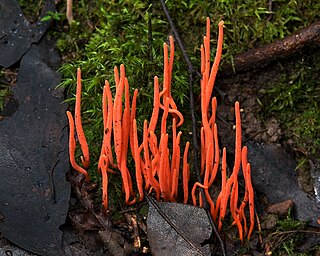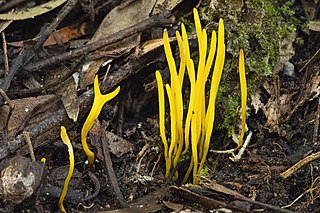Edred John Henry Corner FRS was an English mycologist and botanist who occupied the posts of assistant director at the Singapore Botanic Gardens (1929–1946) and Professor of Tropical Botany at the University of Cambridge (1965–1973). Corner was a Fellow of Sidney Sussex College from 1959.

The Clavariaceae are a family of fungi in the order Agaricales. Originally the family contained most of the clavarioid fungi, but in its current sense is more restricted, albeit with a greater diversity of basidiocarp forms. Basidiocarps are variously clavarioid or agaricoid (mushroom-shaped), less commonly corticioid or hydnoid.

The Physalacriaceae are a family of fungi in the order Agaricales. Species in the family have a widespread distribution, ranging from the Arctic, (Rhizomarasmius), to the tropics, e.g. Gloiocephala, and from marine sites (Mycaureola) and fresh waters (Gloiocephala) to semiarid forests (Xerula).

Ramariopsis is a genus of coral fungi in the family Clavariaceae. The genus has a collectively widespread distribution and contains about 40 species. The name means 'having the appearance of Ramaria'.

Ramariopsis kunzei is an edible species of coral fungi in the family Clavariaceae, and the type species of the genus Ramariopsis. It is commonly known as white coral because of the branched structure of the fruit bodies that resemble marine coral. The fruit bodies are up to 5 cm (2.0 in) tall by 4 cm (1.6 in) wide, with numerous branches originating from a short rudimentary stem. The branches are one to two millimeters thick, smooth, and white, sometimes with yellowish tips in age. Ramariopsis kunzei has a widespread distribution, and is found in North America, Europe, Asia, and Australia.

The clavarioid fungi are a group of fungi in the Basidiomycota typically having erect, simple or branched basidiocarps that are formed on the ground, on decaying vegetation, or on dead wood. They are colloquially called club fungi and coral fungi.

Clavaria zollingeri, commonly known as the violet coral or the magenta coral, is a widely distributed species of fungus. It produces striking tubular, purple to pinkish-violet fruit bodies that grow up to 10 cm (3.9 in) tall and 7 cm (2.8 in) wide. The extreme tips of the fragile, slender branches are usually rounded and brownish. A typical member of the clavarioid or club fungi, Clavaria zollingeri is saprobic, and so derives nutrients by breaking down organic matter. The fruit bodies are typically found growing on the ground in woodland litter, or in grasslands. Variations in branching and color can often be used to distinguish C. zollingeri from similarly colored coral fungi such as Alloclavaria purpurea and Clavulina amethystina, although microscopy is required to reliably identify the latter species.

Clavulinopsis amoena is a clavarioid fungus in the family Clavariaceae. It forms slender, cylindrical, golden-yellow fruiting bodies that grow on the ground among plant litter. It was originally described from Indonesia and appears to be distributed in temperate areas of the southern hemisphere.
Clavulina gigartinoides is a species of coral fungus in the family Clavulinaceae. Found in Malaysia, it was described by British botanist E.J.H. Corner in 1950.
Clavulina geoglossoides is a species of coral fungus in the family Clavulinaceae. It occurs in New Zealand.
Clavulina floridana is a species of fungus in the family Clavulinaceae. It was originally described by Rolf Singer as Clavaria floridana in 1945, then E.J.H. Corner transferred it to Clavulina in 1950.
Clavulina delicia is a species of fungus in the family Clavulinaceae. Originally named Clavaria delicia by Miles Joseph Berkeley in 1856, it was transferred to Clavulina in 1950 by British botanist E.J.H. Corner. It occurs in South America.
Clavulina decipiens is a species of fungus in the family Clavulinaceae. It was described by British botanist E.J.H. Corner in 1950.
Clavulina amethystinoides is a species of fungus in the family Clavulinaceae. It was originally named Clavaria amethystinoides by American mycologist Charles Horton Peck in 1907; E.J.H. Corner transferred it to Clavulina in 1950.
Clavulina amazonensis is a species of fungus in the family Clavulinaceae. Found in South America, it was described by British mycologist E.J.H. Corner in 1970.
Clavulina gracilis is a species of coral fungus in the family Clavulinaceae. It was described by E.J.H. Corner in 1950.
Clavulina ingrata is a species of coral fungus in the family Clavulinaceae. Found in Malaysia, it was described by E.J.H. Corner in 1950.

Clavulina ornatipes is a species of coral fungus in the family Clavulinaceae. First described as Clavaria ornatipes by Charles Horton Peck in 1908, it was transferred to Clavulina by E.J.H. Corner in 1950.

Clavulinopsis laeticolor, commonly known as the golden fairy club or handsome club, is a clavarioid fungus in the family Clavariaceae. It forms slender, cylindrical, yellow fruit bodies that grow on the ground in woodland litter or in agriculturally unimproved grassland. It was originally described from Cuba and is part of a species complex as yet unresolved.

Clavulinopsis sulcata is a clavarioid fungus in the family Clavariaceae and is the type species of the genus Clavulinopsis. It forms very long, slender, cylindrical pinkish or orange fruiting bodies that grow on the ground among plant litter.







